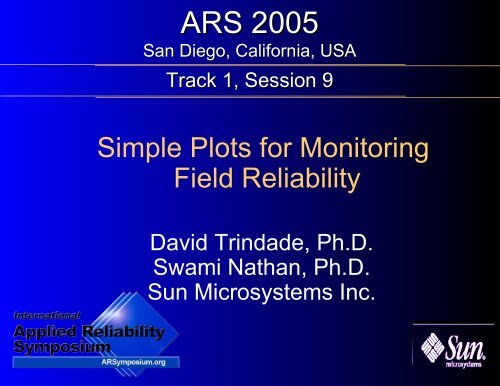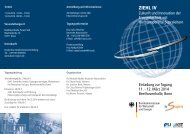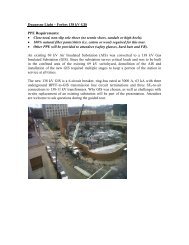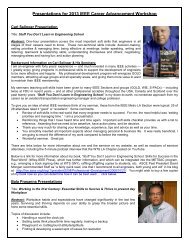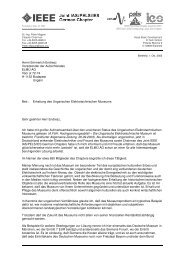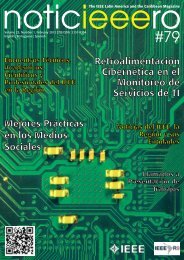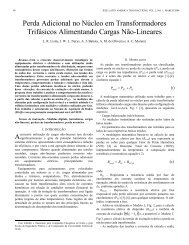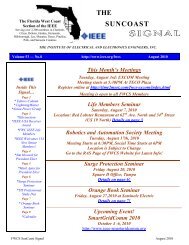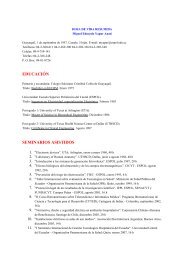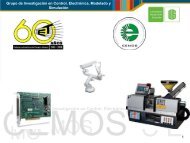Simple Plots for Monitoring Field Reliability
Simple Plots for Monitoring Field Reliability
Simple Plots for Monitoring Field Reliability
You also want an ePaper? Increase the reach of your titles
YUMPU automatically turns print PDFs into web optimized ePapers that Google loves.
ARS 2005<br />
San Diego, Cali<strong>for</strong>nia, USA<br />
Track 1, Session 9<br />
<strong>Simple</strong> <strong>Plots</strong> <strong>for</strong> <strong>Monitoring</strong><br />
<strong>Field</strong> <strong>Reliability</strong><br />
David Trindade, Ph.D.<br />
Swami Nathan, Ph.D.<br />
Sun Microsystems Inc.
Introduction<br />
<strong>Reliability</strong> is a key concern of Sun customers<br />
What is the reliability ?<br />
What should be the reliability ?<br />
MTBF (Mean Time Between Failures) is the<br />
typical metric used <strong>for</strong> communicating<br />
reliability.<br />
MTBFs imply many assumptions and are<br />
prone to misinterpretation.<br />
Dave Trindade, Swami Nathan, Sun Microsystems<br />
Track 1<br />
Session 9<br />
Slide Number: 2
Introduction<br />
Customers want to know more than MTBFs<br />
What are the causes of downtime ?<br />
What can we expect going <strong>for</strong>ward ?<br />
Pareto, stacked bar, pie, and other static<br />
charts are often used to convey analysis<br />
results.<br />
Such charts can mislead by hiding important<br />
effects related to time.<br />
Dave Trindade, Swami Nathan, Sun Microsystems<br />
Track 1<br />
Session 9<br />
Slide Number: 3
Agenda<br />
MTBF Limitations<br />
Repairable Systems Analysis <strong>for</strong> Age and<br />
Calendar Time<br />
Time Dependent Cause Plotting<br />
Case Studies<br />
Summary<br />
Dave Trindade, Swami Nathan, Sun Microsystems<br />
Track 1<br />
Session 9<br />
Slide Number: 4
MTBF Hides In<strong>for</strong>mation<br />
Example with 3 failures in 3000 hours...<br />
***<br />
System 1<br />
Dave Trindade, Swami Nathan, Sun Microsystems<br />
1000 2000<br />
System 2 * * *<br />
1000 2000<br />
***<br />
System 3<br />
1000 2000<br />
Track 1<br />
Session 9<br />
3000<br />
3000<br />
3000<br />
MTBFs are the same, implying equal reliability.<br />
Slide Number: 5
Dangers of Extrapolating to an MTBF<br />
During the years 1996-1998, the average<br />
annual death rate in the US <strong>for</strong> children ages<br />
5-14 was 20.8 per 100,000 resident<br />
population.<br />
The average failure rate is thus 0.02%/yr<br />
The MTBF is 4800 years!!<br />
Dave Trindade, Swami Nathan, Sun Microsystems<br />
Track 1<br />
Session 9<br />
Slide Number: 6
MTBF Assumptions: When is it OK ?<br />
Repairable Systems<br />
Renewal Process (“as good as new”)<br />
Times between failures are independently and<br />
identically distributed<br />
Single distribution of times between failures<br />
Assume Exponential Distribution<br />
Constant hazard rate (time independent)<br />
No trend (constant recurrence rate RR or<br />
ROCOF)<br />
Homogeneous Poisson Process<br />
Dave Trindade, Swami Nathan, Sun Microsystems<br />
Track 1<br />
Session 9<br />
Slide Number: 7
MTBF Implications <strong>for</strong> HPP<br />
For a 100 repairable systems, by the time<br />
they all reach the MTBF, on the average<br />
there will be 100 failures. #Systems(# Fails/System)<br />
37(0)<br />
37(1)<br />
18(2)<br />
6(3)<br />
2(4)<br />
Customers can focus on the worst machines<br />
and perceive a reliability problem.<br />
Dave Trindade, Swami Nathan, Sun Microsystems<br />
Track 1<br />
Session 9<br />
Slide Number: 8
MTBF-Inadequate <strong>Reliability</strong> Measure<br />
Valid only <strong>for</strong> a constant RR (HPP)<br />
Treats all system hours and all failures as<br />
equivalent and ignores age effects<br />
Data is rarely checked <strong>for</strong> validity of HPP<br />
Customers accustomed to MTBF usage<br />
MTBFs are often quoted with imprecise<br />
definition of failure (not = outage)<br />
We need a better and more accurate<br />
approach to measure reliability.<br />
Dave Trindade, Swami Nathan, Sun Microsystems<br />
Track 1<br />
Session 9<br />
Slide Number: 9
Parametric Methods<br />
MLE methods <strong>for</strong> HPP and NHPP are<br />
extremely powerful and rigorous.<br />
Lots of literature.<br />
Too complex <strong>for</strong> communicating with<br />
management and customers.<br />
Some customers tend to think “in<strong>for</strong>mation is<br />
hidden with statistical cleverness”.<br />
Showing a maximum likelihood equation is<br />
not the fastest way to gain credibility with<br />
customers.<br />
Dave Trindade, Swami Nathan, Sun Microsystems<br />
Track 1<br />
Session 9<br />
Slide Number: 10
Time Dependent <strong>Reliability</strong> (TDR)<br />
TDR is a Sun Microsystems acronym <strong>for</strong><br />
non-parametric analysis of reliability data.<br />
Novice practitioners relate more easily to the<br />
non-parametric approach compared to<br />
indiscriminate modeling with various<br />
distributions.<br />
Dave Trindade, Swami Nathan, Sun Microsystems<br />
Track 1<br />
Session 9<br />
Slide Number: 11
Cumulative Plot<br />
# Fails<br />
12 machine A<br />
10<br />
8<br />
6<br />
4<br />
2<br />
0<br />
0 100 200 300 400 500 600<br />
Cumulative plot shows failure history as number of failures<br />
(repairs) Vs time <strong>for</strong> each machine<br />
Dave Trindade, Swami Nathan, Sun Microsystems<br />
Age (days)<br />
Track 1<br />
Session 9<br />
machine B<br />
machine C<br />
machine D<br />
Slide Number: 12
Cumulative <strong>Plots</strong> reveal trends<br />
Cumulative No. Repairs<br />
11<br />
10<br />
9<br />
8<br />
7<br />
6<br />
5<br />
4<br />
3<br />
2<br />
1<br />
Stable System – No Trend<br />
0<br />
0 100 200 300 400 500 600 700 800<br />
System Age (Hours)<br />
All 3 plots have 10 fails in 700 hours leading to an MTBF of<br />
70 hours. Clearly these behaviors are different<br />
Dave Trindade, Swami Nathan, Sun Microsystems<br />
Track 1<br />
Cumulative No. Repairs<br />
Cumulative No. Repairs<br />
11<br />
10<br />
11<br />
10<br />
9<br />
8<br />
7<br />
6<br />
5<br />
4<br />
3<br />
2<br />
1<br />
9<br />
8<br />
7<br />
6<br />
5<br />
4<br />
3<br />
2<br />
1<br />
0<br />
0 100 200 300 400 500 600 700 800<br />
0<br />
0 100 200 300 400 500 600 700 800<br />
Session 9<br />
Improving System<br />
System Age (Hours)<br />
Worsening System<br />
System Age (Hours)<br />
Slide Number: 13
Mean Cumulative Function (MCF)<br />
MCF is the average of the cumulative plots<br />
across a group of systems at risk at any<br />
point in time.<br />
MCF is obtained from a vertical slice across<br />
the individual cumulative plots at a time<br />
point.<br />
MCF is the average number of failures of a<br />
group of systems at a particular age.<br />
Dave Trindade, Swami Nathan, Sun Microsystems<br />
Track 1<br />
Session 9<br />
Slide Number: 14
MCF from Cumulative <strong>Plots</strong><br />
# Fails<br />
12 machine A<br />
10<br />
8<br />
6<br />
4<br />
2<br />
0<br />
0 100 200 300 400 500 600<br />
Dave Trindade, Swami Nathan, Sun Microsystems<br />
Age (days)<br />
Track 1<br />
Session 9<br />
machine B<br />
machine C<br />
machine D<br />
Average at each vertical time slice is the MCF. We show<br />
slice at 100 hours on a collection of 4 cumulative plots.<br />
Slide Number: 15
MCF and Cumulative <strong>Plots</strong><br />
Average # Failures (MCF)<br />
11<br />
10<br />
9<br />
8<br />
7<br />
6<br />
5<br />
4<br />
3<br />
2<br />
1<br />
0<br />
0 50 100 150 200 250 300 350 400 450 500 550<br />
Dave Trindade, Swami Nathan, Sun Microsystems<br />
Age (in days since install)<br />
Note: Steps replaced with connecting lines<br />
Track 1<br />
Session 9<br />
MCF<br />
machine A<br />
machine B<br />
machine C<br />
machine D<br />
Slide Number: 16
Multicensoring Issues<br />
Because systems are installed at different times<br />
throughout the year, system ages will differ<br />
resulting in multicensored data.<br />
Right censored data has no failure in<strong>for</strong>mation<br />
beyond a specific system age; e.g., if a machine is<br />
100 days old it cannot contribute in<strong>for</strong>mation<br />
regarding reliability at 150 days of operation.<br />
Left censored data has no in<strong>for</strong>mation be<strong>for</strong>e a<br />
specific date; e.g., data collection begins on Jan<br />
2004 and no failure history is available<br />
MCF accounts <strong>for</strong> the number of systems at risk at<br />
any age or date.<br />
Dave Trindade, Swami Nathan, Sun Microsystems<br />
Track 1<br />
Session 9<br />
Slide Number: 17
Right Censored Data<br />
System A<br />
System B<br />
System C<br />
System A<br />
System B<br />
System C<br />
No. Systems<br />
Dave Trindade, Swami Nathan, Sun Microsystems<br />
3<br />
2<br />
1<br />
0<br />
January June December<br />
Today<br />
Date<br />
0 90 180<br />
270<br />
Age (in Days)<br />
0<br />
90 180 270<br />
Age (in Days)<br />
Track 1<br />
Multicensored Data<br />
Systems Operational Versus Age<br />
Session 9<br />
Slide Number: 18
Left Censored Data<br />
System A<br />
System B<br />
System C<br />
System A<br />
System B<br />
System C<br />
No. Systems<br />
Dave Trindade, Swami Nathan, Sun Microsystems<br />
3<br />
2<br />
1<br />
0<br />
2000 2001 2002 2003<br />
Data Begins<br />
0<br />
Date<br />
0 1 2 3<br />
Age (in Years)<br />
Systems Operational Versus Age<br />
1 2 3<br />
Age (in Years)<br />
Track 1<br />
Session 9<br />
Today<br />
Multicensored Data<br />
Slide Number: 19
MCF Calculation (3 systems)<br />
Time (Hrs)<br />
Number of Systems<br />
at Risk<br />
Fails/System<br />
MCF<br />
33<br />
Confidence bounds can be computed <strong>for</strong> MCF<br />
Dave Trindade, Swami Nathan, Sun Microsystems<br />
3<br />
1/3<br />
1/3<br />
135<br />
3<br />
1/3<br />
2/3<br />
247<br />
3<br />
1/3<br />
3/3<br />
300<br />
3<br />
3/3<br />
Track 1<br />
318<br />
2<br />
1/2<br />
3/3+1/<br />
2<br />
368<br />
2<br />
1/2<br />
3/3+2/2<br />
Session 9<br />
500<br />
2<br />
3/3+2/<br />
2<br />
582<br />
1<br />
1/1<br />
3/3+2/2<br />
+1/1<br />
700<br />
1<br />
3/3+2/2<br />
+1/1<br />
Slide Number: 20
MCF calculation : Data Template<br />
History on every machine, including systems<br />
without failures.<br />
Note install, begin, failure, and end event<br />
dates.<br />
Dave Trindade, Swami Nathan, Sun Microsystems<br />
Track 1<br />
Session 9<br />
Slide Number: 21
MCF calculation: Confidence Intervals<br />
Dave Trindade, Swami Nathan, Sun Microsystems<br />
Confidence limits based on Nelson's book.<br />
Track 1<br />
Session 9<br />
Slide Number: 22
MCF, CI, Cumulative <strong>Plots</strong><br />
Average # Failures (MCF)<br />
Dave Trindade, Swami Nathan, Sun Microsystems<br />
13<br />
12<br />
11<br />
10<br />
9<br />
8<br />
7<br />
6<br />
5<br />
4<br />
3<br />
2<br />
1<br />
0<br />
0 50 100 150 200 250 300 350 400 450 500 550<br />
In one year of operation this population has 5<br />
fails/machine with an upper bound of 7.<br />
Machine A clearly has higher than average<br />
failures at all ages.<br />
Age (in days since install)<br />
Track 1<br />
Session 9<br />
MCF<br />
Lower<br />
Upper<br />
machine A<br />
machine B<br />
machine C<br />
machine D<br />
Slide Number: 23
Detecting anomalous machines<br />
Naïve Confidence Intervals (from Nelson)<br />
If machine cumulative function is well above<br />
the upper bound it is deemed anomalous.<br />
Method works well on small sample sizes<br />
(eyeball approach)<br />
Graphically focuses attention on machines<br />
with high failures (over all or in small time<br />
windows).<br />
Prediction intervals on MCF will be more<br />
accurate.<br />
Dave Trindade, Swami Nathan, Sun Microsystems<br />
Track 1<br />
Session 9<br />
Slide Number: 24
Glosup's Method<br />
One machine is removed from the<br />
population and the MCF is computed.<br />
MCF with N machines is compared with<br />
MCF with (N-1) machines <strong>for</strong> all<br />
combinations.<br />
Anomalous machine is based on the<br />
difference between these MCF<br />
combinations.<br />
See reference.<br />
Dave Trindade, Swami Nathan, Sun Microsystems<br />
Track 1<br />
Session 9<br />
Slide Number: 25
Heavlin's Method<br />
Based on Cochran-Mantel-Hanzel statistic<br />
<strong>for</strong> 2X2 contingency tables.<br />
Powerful but computationally intensive<br />
To be published.<br />
Dave Trindade, Swami Nathan, Sun Microsystems<br />
Track 1<br />
Session 9<br />
Slide Number: 26
Recurrence Rate<br />
A key characteristic of the MCF is the<br />
recurrence rate determined from the slope of<br />
the MCF at any point in time.<br />
The local slope represents the rate at which<br />
failures are occurring.<br />
Local slope is estimated by fitting a line to a<br />
group of points in a “window”.<br />
Degree of smoothing is the number of points<br />
used in estimating the tangent to the MCF.<br />
Slope(X,Y) functions in spreadsheets can be<br />
used to obtain recurrence rates easily.<br />
Dave Trindade, Swami Nathan, Sun Microsystems<br />
Track 1<br />
Session 9<br />
Slide Number: 27
Recurrence Rate : Step by Step<br />
Dave Trindade, Swami Nathan, Sun Microsystems<br />
Track 1<br />
Session 9<br />
5 point slope<br />
Slide Number: 28
Recurrence Rate Vs Age<br />
Recurrence rate peak at age 450 caused by single system.<br />
Dave Trindade, Swami Nathan, Sun Microsystems<br />
Track 1<br />
Session 9<br />
Slide Number: 29
Recurrence Rate Vs Age Example<br />
Recurrence Rate (per day)<br />
0.075<br />
0.070<br />
0.065<br />
0.060<br />
0.055<br />
0.050<br />
0.045<br />
0.040<br />
0.035<br />
0.030<br />
0.025<br />
0.020<br />
0.015<br />
0.010<br />
0.005<br />
0.000<br />
0 50 100 150 200 250 300 350 400 450<br />
Clearly rate of failures is decreasing with age.<br />
“Peaks” or “spikes” are related to multiple fails in<br />
short time periods indicating possible<br />
misdiagnosis or dead on arrival (DOA) spares.<br />
Dave Trindade, Swami Nathan, Sun Microsystems<br />
Recurrence Rate vs Age<br />
Age (in days since install)<br />
Track 1<br />
Session 9<br />
Recurrence Rate<br />
Slide Number: 30
Calendar Time Analysis<br />
Applications of patches, upgrades to faster<br />
processors, changing of operational policy of<br />
systems administrators, etc., affect a<br />
population of machines which are at several<br />
ages on a single date or calendar window.<br />
These effects are captured by MCF and<br />
recurrence rates versus calendar time<br />
instead of age.<br />
Slope(X,Y) in spreadsheets handles both<br />
age (numbers) or dates. Dates are<br />
automatically converted to days elapsed.<br />
Dave Trindade, Swami Nathan, Sun Microsystems<br />
Track 1<br />
Session 9<br />
Slide Number: 31
Calendar Time Analysis<br />
Cum Repairs<br />
Cum Repairs<br />
11/16/1999<br />
1/15/2000<br />
3/15/2000<br />
System 1<br />
System 2<br />
5/14/2000<br />
Cumulative Plot Versus Calendar Date<br />
System 1<br />
System 2<br />
Cumulative Plot Versus System Age<br />
0 100 200 300 400 500 600 700 800 900<br />
7/13/2000<br />
Dave Trindade, Swami Nathan, Sun Microsystems<br />
9/11/2000<br />
System Age (Days)<br />
11/10/2000<br />
1/9/2001<br />
3/10/2001<br />
Date<br />
5/9/2001<br />
7/8/2001<br />
9/6/2001<br />
11/5/2001<br />
1/4/2002<br />
3/5/2002<br />
5/4/2002<br />
Track 1<br />
Repairs/Day<br />
Repairs/Day<br />
System 1<br />
System 2<br />
Repair Rate Versus System Age<br />
0 100 200 300 400 500 600 700 800 900<br />
System Age (Days)<br />
Repair Rate Versus Calendar Date<br />
Simulated data: Two systems. One installed 1/1/2001and second 4/1/2001.<br />
Software upgrades on both systems on 6/1/2001.<br />
11/16/1999<br />
1/15/2000<br />
3/15/2000<br />
System 1<br />
System 2<br />
5/14/2000<br />
7/13/2000<br />
9/11/2000<br />
11/10/2000<br />
1/9/2001<br />
Session 9<br />
3/10/2001<br />
Date<br />
5/9/2001<br />
7/8/2001<br />
9/6/2001<br />
11/5/2001<br />
1/4/2002<br />
3/5/2002<br />
5/4/2002<br />
Slide Number: 32
Recurrence Rate Vs Date Example<br />
Recurrence Rate (per year)<br />
4<br />
3.5<br />
3<br />
2.5<br />
2<br />
1.5<br />
1<br />
0.5<br />
0<br />
12/10/02 03/20/03 06/28/03 10/06/03 01/14/04 04/23/04<br />
Sharp increase in rate of fails in Apr-Jun followed by stable rate<br />
Rate decreases by half from January.<br />
Spike was related to multiple fails on a single machine in a<br />
short time period.<br />
Dave Trindade, Swami Nathan, Sun Microsystems<br />
Recurrence Rate vs Date<br />
Date<br />
Track 1<br />
Session 9<br />
Recurrence rate (fails/yr)<br />
1/MTBF<br />
Slide Number: 33
Failure Cause Pareto<br />
# Events<br />
17<br />
16<br />
15<br />
14<br />
13<br />
12<br />
11<br />
10<br />
9<br />
8<br />
7<br />
6<br />
5<br />
4<br />
3<br />
2<br />
1<br />
0<br />
Pareto charts are static.<br />
Plot does not show which causes have been<br />
remediated and which ones are current threats.<br />
Dave Trindade, Swami Nathan, Sun Microsystems<br />
Failure Cause Pareto<br />
Cause A Cause B Cause C Cause D Cause E<br />
Track 1<br />
Session 9<br />
# Events<br />
Slide Number: 34
Failure Cause <strong>Plots</strong><br />
# Events<br />
17<br />
16<br />
15<br />
14<br />
13<br />
12<br />
11<br />
10<br />
9<br />
8<br />
7<br />
6<br />
5<br />
4<br />
3<br />
2<br />
1<br />
0<br />
01/01/03 03/17/03 05/31/03 08/14/03 10/28/03 01/11/04<br />
Failure cause can be plotted against age or date.<br />
Cause D was remediated in '03 while Cause A is a<br />
current threat.<br />
Conveys time evolution of customer problems.<br />
Dave Trindade, Swami Nathan, Sun Microsystems<br />
Cause vs Date<br />
Date<br />
Track 1<br />
Session 9<br />
Cause A<br />
Cause B<br />
Cause C<br />
Cause D<br />
Cause E<br />
Slide Number: 35
Additional uses of MCFs<br />
MCF Vs system age can be used to<br />
compare various (sub) populations despite<br />
multicensoring.<br />
Machines at different customer sites.<br />
Machines belonging to the same customer but<br />
located at different datacenters.<br />
Machines of different vintages e.g., manufactured<br />
in 2003 Vs 2004.<br />
Machines per<strong>for</strong>ming different functions e.g.,<br />
production Vs development.<br />
Case studies will illustrate these uses.<br />
Dave Trindade, Swami Nathan, Sun Microsystems<br />
Track 1<br />
Session 9<br />
Slide Number: 36
NHPP Fitting<br />
MCF<br />
Dave Trindade, Swami Nathan, Sun Microsystems<br />
MCF and NHPP Model<br />
Age<br />
Example of fitting a power law model to an MCF<br />
The parametric fit to a non parametric MCF can be used<br />
<strong>for</strong> prediction and extrapolation.<br />
Track 1<br />
Session 9<br />
Slide Number: 37
Case Study 1<br />
Customer with East Coast Vs West Coast data centers. Air<br />
conditioning issues caused West coast problems.<br />
Dave Trindade, Swami Nathan, Sun Microsystems<br />
Track 1<br />
Session 9<br />
Slide Number: 38
Case Study 2<br />
Comparison across customers, common plat<strong>for</strong>m.<br />
Dave Trindade, Swami Nathan, Sun Microsystems<br />
Track 1<br />
Session 9<br />
Slide Number: 39
Trans<strong>for</strong>ming Sun<br />
MTBF represented the com<strong>for</strong>t zone.<br />
Struggled to push TDR until successes<br />
achieved at various customers in resolving<br />
reliability issues.<br />
“You guys have hit a home run.”<br />
“Some of the best work I've seen from Sun.”<br />
Training of Sun engineers and field service<br />
personnel in TDR usage is ongoing.<br />
Sun has developed software tools <strong>for</strong><br />
internal use to facilitate analysis and<br />
generate reports.<br />
Dave Trindade, Swami Nathan, Sun Microsystems<br />
Track 1<br />
Session 9<br />
Slide Number: 40
Summary<br />
The analysis of repairable systems does<br />
not have to be complicated.<br />
There are better ways to measure reliability<br />
than just MTBF.<br />
Measuring and monitoring repairable<br />
system reliability can be greatly facilitated<br />
by the use of simple but very powerful<br />
graphical techniques.<br />
Dave Trindade, Swami Nathan, Sun Microsystems<br />
Track 1<br />
Session 9<br />
Slide Number: 41
Benefits<br />
These procedures have been applied very<br />
effectively at Sun Microsystems <strong>for</strong> monitoring<br />
the reliability of Sun equipment at many<br />
customers.<br />
These methods have allowed Sun engineers to<br />
quickly identify trends, anomalous systems,<br />
unusual behavior, the effects of hardware and<br />
software changes, maintenance practices, and<br />
installation actions.<br />
Customers presented with TDR analysis reports<br />
have responded very favorably to these revealing<br />
charts.<br />
Dave Trindade, Swami Nathan, Sun Microsystems<br />
Track 1<br />
Session 9<br />
Slide Number: 42
Where to Get More In<strong>for</strong>mation<br />
Glosup, J., “Detecting Multiple Populations within a Collection of Repairable<br />
Systems”, Joint Statistical Meetings, Toronto, Canada, 2004<br />
Lawson, J.S., Wesselmann, C.W., Scott, D.T.,''<strong>Simple</strong> <strong>Plots</strong> Improve Software<br />
<strong>Reliability</strong> Prediction Models'', Quality Engineering, Vol 15. No. 3. pp411-417,<br />
2003.<br />
Nelson W., “Graphical Analysis of System Repair Data”, Journal of Quality<br />
Technology, 17, 140-146.<br />
Nelson, W., Recurrence Events Data Analysis <strong>for</strong> Product Repairs, Disease<br />
Recurrences and Other Applications, ASA-SIAM series on Statistics and<br />
Applied Probability, 2003.<br />
Tobias, P.A., Trindade, D.C., Applied <strong>Reliability</strong>, Chapman & Hall/CRC, 1995.<br />
Trindade, D.C., “An APL Program to Numerically Differentiate Data“, IBM TR<br />
Report 19.0361, January 12, 1975<br />
Trindade, D.C., Nathan, S., “<strong>Simple</strong> <strong>Plots</strong> <strong>for</strong> <strong>Monitoring</strong> the <strong>Field</strong> <strong>Reliability</strong> of<br />
Repairable Systems”, Annual <strong>Reliability</strong> and Maintainability Symposium,<br />
Alexandria, Virginia, 2005<br />
Usher, J.S., ''Case Study: <strong>Reliability</strong> Models and Misconceptions“, Quality<br />
Engineering, Vol. 6, No. 2, pp 261-271.<br />
Dave Trindade, Swami Nathan, Sun Microsystems<br />
Track 1<br />
Session 9<br />
Slide Number: 43
Presenter’s Biographical Sketch<br />
Dr. David Trindade is a Distinguished Engineer at Sun Microsystems. Formerly<br />
he was a Senior Fellow at AMD. His fields of expertise include reliability,<br />
statistical analysis, and modeling of components, systems, and software,<br />
applied statistics, especially design of experiments (DOE), and statistical<br />
process control (SPC). He is co-author (with Dr. Paul Tobias) of the book<br />
Applied <strong>Reliability</strong>, 2nd ed., published in 1995. He has authored many papers<br />
and presented at many international conferences. He has a BS in physics, an<br />
MS in material sciences and semiconductor physics, an MS in statistics , and a<br />
Ph.D. in mechanical engineering and statistics. He has been an adjunct<br />
lecturer at the University of Vermont and Santa Clara University.<br />
e-mail: david.trindade@sun.com<br />
Dr. Swami Nathan is a Senior Staff Engineer in Sun Microsystems. His field of<br />
interest is field data analysis, statistical analysis and reliability/availability<br />
modeling of complex systems. He received his B.Tech from Indian Institute of<br />
Technology, and M.S. and Ph.D. in reliability engineering from the University of<br />
Maryland, College Park. He has authored over a dozen papers and presented<br />
at international conferences and holds two patents.<br />
email: swami.nathan@sun.com<br />
Dave Trindade, Swami Nathan, Sun Microsystems<br />
Track 1<br />
Session 9<br />
Slide Number: 44


